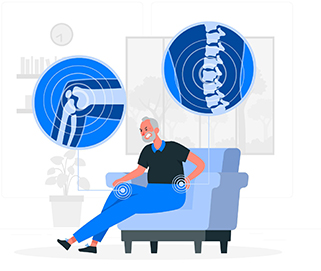Insight Orthopedics & Sports Medicine – Shoulder bursitis, also known as subacromial bursitis, is a condition that occurs when the bursa in the shoulder joint becomes inflamed. The bursa is a small fluid-filled sac that acts as a cushion between the bones and soft tissues to minimize friction during movement. Repetitive overhead movements performed during sports like tennis or swimming, lifting heavy objects, and reaching overhead can all lead to the inflammation of the bursa. Because many shoulder conditions share similar symptoms, here are the 10 most common signs of shoulder bursitis, including when to seek treatment from an orthopedic specialist.
Pain
The most common symptom someone with shoulder bursitis will experience is pain. The outer part of the shoulder is typically where pain will occur and it usually worsens with specific movements like lifting your arm overhead or reaching from behind. Pain tends to vary from sharp to dull.

Radiating Pain
It is also possible for shoulder bursitis pain to radiate down the arm and into the neck and upper back. This is particularly common if the inflammation occurs near these parts of the body.
Tenderness
In addition to pain, the affected area will also likely be tender to the touch. Pressing the outer part of the shoulder or anywhere near the bursa should result in pain or discomfort.

Swelling
Inflammation of the bursa can cause swelling in the shoulder. This is often accompanied by a visible bulge and a feeling of tightness in the shoulder area.

Limited Range of Motion
Stiffness and limited range of motion is a common symptom with shoulder bursitis. People with this condition have difficulty with overhead arm movements, reaching, and performing other common shoulder motions without pain.
Pain During Daily Activities
In addition to reaching, stretching, and lifting, it is common to experience pain during everyday activities. Carrying bags or backpacks, sleeping on the affected shoulder, typing or using a computer mouse, and driving can all contribute to shoulder bursitis pain.
Pain While Resting
It is also possible to experience bursitis pain while resting your shoulder. However, this pain is generally intermittent and varies in intensity.

Warmth or Redness
Inflammation of the bursa can sometimes result in increased blood flow to the affected area, leading to warmth and redness. Although this symptom is not typically associated with shoulder bursitis, it is possible in some cases, particularly when inflammation is severe or there is an underlying infection.
Painful Clicking or Snapping
A painful clicking or snapping sensation in the joint is not generally associated with shoulder bursitis, but it is possible in some patients. It may also be the result of an underlying condition such as tendonitis or a tear.

Shoulder bursitis is a painful condition, but in most cases it will improve with an accurate diagnosis and conservative treatment. If you experience persistent shoulder pain or any of these symptoms, it is important to speak to a healthcare professional as soon as possible. Early intervention is key for alleviating symptoms and preventing further complications. To schedule an appointment at Insight Orthopedics & Sports Medicine or to learn more about our services, contact us today.
FAQ
Q: How is shoulder bursitis diagnosed?
A: Shoulder bursitis is typically diagnosed by a healthcare professional through a physical exam. During this time, they will assess your symptoms and range of motion. Imaging tests, such as x-rays and MRI, may also be used to confirm the diagnosis and rule out the possibility of another condition.
Q: What are my treatment options for shoulder bursitis?
A: Most shoulder bursitis can be treated with a combination of rest, ice therapy, nonsteroidal anti-inflammatory drugs (NSAIDs), corticosteroid injections, and physical therapy.
Q: How long will it take to recover from shoulder bursitis?
A: Recovery from shoulder bursitis will vary depending on the severity of your condition. In most cases, symptoms will improve within a few weeks of conservative treatment.

